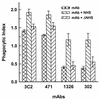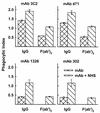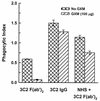Fc-dependent and Fc-independent opsonization of Cryptococcus neoformans by anticapsular monoclonal antibodies: importance of epitope specificity
- PMID: 12010967
- PMCID: PMC127994
- DOI: 10.1128/IAI.70.6.2812-2819.2002
Fc-dependent and Fc-independent opsonization of Cryptococcus neoformans by anticapsular monoclonal antibodies: importance of epitope specificity
Abstract
Monoclonal antibodies (MAbs) reactive with glucuronoxylomannan (GXM), the major capsular polysaccharide of the yeast Cryptococcus neoformans, produce distinct capsular reactions when viewed by differential interference contrast microscopy. These reactions depend on the epitope specificity of the antibody. Opsonic activities of immunoglobulin G1 (IgG1) MAbs that produce patterns termed rim and puffy were examined. Rim-pattern MAbs are reactive with an epitope shared by GXM serotypes A, B, C, and D. Puffy-pattern MAbs are reactive only with serotypes A and D. In phagocytosis assays, using serotype A cells and resident murine peritoneal macrophages, rim-pattern MAbs were markedly more opsonic than puffy-pattern MAbs. F(ab')(2) fragments of rim-pattern MAbs were synergistic with heat-labile factors in normal human serum for opsonization of the yeast. F(ab')(2) fragments of puffy-pattern MAbs were also synergistic with normal serum in opsonization but at a much lower level than fragments of rim-pattern MAbs. Normal serum alone was not opsonic. F(ab')(2) fragments of rim-pattern MAbs, but not puffy-pattern MAbs, stimulated phagocytosis of encapsulated cryptococci in the absence of serum. This serum-independent opsonic action of F(ab')(2) fragments was abrogated by pretreatment of macrophages with purified GXM, suggesting the involvement of a phagocyte GXM receptor. The results indicate that (i) there are multiple mechanisms by which anticapsular IgG MAbs facilitate phagocytosis of encapsulated cryptococci, (ii) some anti-GXM antibodies are opsonic in an Fc-independent manner, and (iii) opsonic activity correlates with the capsular reaction and occurs in an epitope-specific manner.
Figures






Similar articles
-
Contribution of epitope specificity to the binding of monoclonal antibodies to the capsule of Cryptococcus neoformans and the soluble form of its major polysaccharide, glucuronoxylomannan.Clin Diagn Lab Immunol. 2003 Mar;10(2):252-8. doi: 10.1128/cdli.10.2.252-258.2003. Clin Diagn Lab Immunol. 2003. PMID: 12626451 Free PMC article.
-
Analysis of human monoclonal antibodies elicited by vaccination with a Cryptococcus neoformans glucuronoxylomannan capsular polysaccharide vaccine.Infect Immun. 1995 Aug;63(8):3005-14. doi: 10.1128/iai.63.8.3005-3014.1995. Infect Immun. 1995. PMID: 7622223 Free PMC article.
-
Bivalency is required for anticapsular monoclonal antibodies to optimally suppress activation of the alternative complement pathway by the Cryptococcus neoformans capsule.Infect Immun. 1998 Apr;66(4):1547-53. doi: 10.1128/IAI.66.4.1547-1553.1998. Infect Immun. 1998. PMID: 9529080 Free PMC article.
-
Mechanism of action of antibody to capsular polysaccharide in Cryptococcus neoformans infection.Front Biosci. 1998 Feb 1;3:d136-51. doi: 10.2741/a270. Front Biosci. 1998. PMID: 9445465 Review.
-
The cellular responses induced by the capsular polysaccharide of Cryptococcus neoformans differ depending on the presence or absence of specific protective antibodies.Curr Mol Med. 2005 Jun;5(4):413-20. doi: 10.2174/1566524054022585. Curr Mol Med. 2005. PMID: 15977997 Review.
Cited by
-
Pneumococcal capsular polysaccharide vaccine-mediated protection against serotype 3 Streptococcus pneumoniae in immunodeficient mice.Infect Immun. 2007 Apr;75(4):1643-50. doi: 10.1128/IAI.01371-06. Epub 2007 Jan 12. Infect Immun. 2007. PMID: 17220309 Free PMC article.
-
Opsonic requirements for dendritic cell-mediated responses to Cryptococcus neoformans.Infect Immun. 2005 Jan;73(1):592-8. doi: 10.1128/IAI.73.1.592-598.2005. Infect Immun. 2005. PMID: 15618199 Free PMC article.
-
PNAG-specific equine IgG1 mediates significantly greater opsonization and killing of Prescottella equi (formerly Rhodococcus equi) than does IgG4/7.Vaccine. 2019 Feb 21;37(9):1142-1150. doi: 10.1016/j.vaccine.2019.01.028. Epub 2019 Jan 26. Vaccine. 2019. PMID: 30691984 Free PMC article.
-
Multiple Disguises for the Same Party: The Concepts of Morphogenesis and Phenotypic Variations in Cryptococcus neoformans.Front Microbiol. 2011 Sep 6;2:181. doi: 10.3389/fmicb.2011.00181. eCollection 2011. Front Microbiol. 2011. PMID: 21922016 Free PMC article.
-
Aggregation of Streptococcus pneumoniae by a pneumococcal capsular polysaccharide-specific human monoclonal IgM correlates with antibody efficacy in vivo.Clin Vaccine Immunol. 2010 May;17(5):713-21. doi: 10.1128/CVI.00410-09. Epub 2010 Mar 3. Clin Vaccine Immunol. 2010. PMID: 20200186 Free PMC article.
References
-
- Bhattacharjee, A. K., J. E. Bennett, and C. P. J. Glaudemans. 1984. Capsular polysaccharides of Cryptococcus neoformans. Rev. Infect. Dis. 6:619-624. - PubMed
Publication types
MeSH terms
Substances
Grants and funding
LinkOut - more resources
Full Text Sources

